Phone: + 39 0541 798670 E-mail: office@bistravel.it
Lazio, Italy
Lazio, ITALIAN REGIONS-
 View Largebtravel_lazio_1
View Largebtravel_lazio_1 -
 View Largebtravel_lazio_2
View Largebtravel_lazio_2 -
 View Largebtravel_lazio_3
View Largebtravel_lazio_3 -
 View Largebtravel_lazio_4
View Largebtravel_lazio_4 -
 View Largebtravel_lazio_5
View Largebtravel_lazio_5 -
 View Largebtravel_lazio_6
View Largebtravel_lazio_6 -
 View Largebtravel_lazio_7
View Largebtravel_lazio_7
This is the cradle of occidental civilization and Christian culture, of lakes and legends, of thermal spas and history, of ancient roads and verdant hills. Lazio is a region of central Italy bordered by the Tyrrhenian Sea,traverse by the waters of the Tiber River and mainly characterized by hills and mountains, while it slopes down near the coast.
This region has different yet complementary features, unblemished sceneries and spectacular horizons among the towns. Visitors can enjoy incredibly beautiful views, like Villa Borghese in Rome, the Italian capital.
Villa Borghese is the most famous city park for walking or cycling. It represents an unparalleled experience between art, containing the Borghese Gallery with its masterpieces, and the nature surrounding it, including lakes and ancient trees. Lazio is also full of spas, whose history is bound to the several thermal water springs that had great success in the Republican Age and continued to be used in the Imperial Age. The Romans built sumptuous thermal baths and we can still admire their vestiges around the territory; first of all, the Terme di Caracalla (now in a state of magnificent ruins) in the heart of Rome.
Tivoli is another spa, but its fame is mainly due to the artistic beauties it contains, like Villa D’Este, with its splendid fountains, gardens and magnificent palace of the Renaissance, and Villa Adriana, the ancient residence of emperor Hadrian. The two villas are on the UNESCO World Heritage List.
For those who prefer the sea, this region offers some pearls such as Gaeta, Sabaudia, San Felice Circeo, Sperlonga and the Islands of Ponza and Ventotene, while those who love lakes will enjoy Bracciano, an enchanting stretch of water encircled by the intense green of the surrounding nature and overlooked by a magnificent 16th-Century castle. Walking along the Medieval streets of the villages by the shores of the lake, visitors can feel that these places are not only bound to the Roman Empire, but were also the theatre of various historical periods. Lake Bolsena, in the area of Viterbo, gives us an example of it, as it is the biggest volcanic lake in Europe and encloses two islands, Bisentina and Martana. This lake combines the charm of lush nature and splendid view,s with the history and traces left by the Etruscans, Romans and successive populations.
Finally, mountain lovers will not be left disappointed by Lazio, thanks to the ski resorts of Terminillo, Livata and Campo Staffi. This land evokes memories of unrivalled places and intense emotions, but also a clear perception of the relentless march of time, that justifies the attempts of our ancestors to challenge time and leave us their remembrance.
The provinces of the region are: Rome (regional capital), Frosinone, Latina, Rieti and Viterbo.

Getting to know and discovering Lazio is like leafing through a history book; each page is connected to the other by a series of events that left their mark. This is Rome, the “Eternal City” in the eyes of visitors; it includes a series of traces to follow in order to reconstruct the course of history.
First stop in the heart of Rome is the solemn Flavian amphitheatre, better known as the Colosseum, where the gladiator games took place; Via dei Fori Imperiali leads along the most important archeological itinerary, a unique set of temples, basilicas, public and sacred buildings and the Roman Forum standing out of the surrounding lush vegetation. The archaeological finds and highly valuable works that were discovered during the excavations are kept in the Capitoline Museums, on the Campidoglio, the acropolis of ancient Rome.
Not far from there is the Theatre of Marcellus and the famous Mouth of Truth, a marble carving representing the face of a faun near the Church of Santa Maria in Cosmedin; this mouth, according to legend, swallows the hands of liars.
The tour of the city continues following the banks of the Tiber to Castel Sant’Angelo, a mausoleum for the Emperor Hadrian, a shelter for popes and a prison. From there, taking the spectacular Via della Conciliazione, we reach the Vatican City, the seat of the Papal State. Here we can admire the famous Piazza San Pietro, with the 16th-Century colonnade by Bernini and the magnificent Sistine Chapel, with its precious Last Judgement, another 16th-Century masterpiece, this time by Michelangelo.
Rome is the main seat of State institutions and we certainly cannot forget its buildings, basilicas and piazzas, like Piazza di Spagna with the famous Spanish steps of Trinità dei Monti, Piazza Farnese and Piazza Navona with Bernini’s Fountain of the Four Rivers, not to mention the 18th-Century Trevi Fountain, where tourists throw coins and express their wish to return to the Eternal City.
In the environs of Rome, the Castelli Romani are a big attraction to those who love cheerful trips to the country to find a cool refuge in hot summer nights. Ostia, on the contrary, besides being a well-known sea resort on Lazio’s coast, encloses the ruins of Ostia Antica (ancient Ostia), the best example of a Roman town that we can still observe today.
Approximately 25 miles from Rome, the town of Tivoli demands a visit, given that it hosts two ancient, lavish estates: Hadrian’s Villa and Villa d’Este, both UNESCO World Heritage Sites.
Other of Lazio’s provinces worth mentioning offer delightful surprises. An important community since Antiquity, Rieti is rich in traces from the Roman and Medieval (when it was a free Comune and then Papal Residence) Ages. Latina, rather, boasts glorious beaches lapped by the Tyrrhennian Sea, along with suggestive old villages and the National Park of Circeo. Plenty of green, verdant land and enchanting Medieval towns characterize Tuscia and its Provincial Capital, Viterbo, oases for relaxation and delicious cuisine, as well as Etruscan heritage and the Via Francigena. Not as well-known, despite the many beauties of the terrain, Ciociaria treats visitors to gorgeous landscapes and evocative places plunged in both natural and historic environments.

In addition to its remarkable cultural heritage, Lazio also possesses fantastic natural monuments – specifically, its parks and natural reserves – the Circeo National Park, the Castelli Romani Regional Natural Park, the natural monument of the Garden of Ninfa and the Regional Natural Park of Appia Antica.
These itineraries through nature take travelers on a discovery of these parks, where birdwatchers can admire many bird species year-round. In the Regional Natural Park of Bracciano-Martignano, the two homonymous lakes are an attraction for sailors and canoeists, while for those who prefer the sea, the Pontine Archipelago offers scuba-divers the opportunity to explore its beautiful seabeds, rich in flora and fauna.
The spas are a prime attraction for those seeking out health and beauty treatments and relaxation; Fiuggi, Tivoli, and Viterbo, just to mention a few of, combine the ancient charm of their origins and wellness with well-equipped, state-of-the-art facilities. Those who prefer the mountains, besides visiting the well-known ski resorts of Terminillo, Leonessa and Arcinazzo, can take trekking, cycle tourism, mountain biking, hiking, climbing and walking excursions among the Region’s peaks.
And what about Rome? As Capital, it offers all that you can find in big cities, in addition to its famous artistic beauties beloved all over the world, cultural itineraries and events, exhibits, festivals and more. Additionally, the big four Roman shopping streets – Via dei Condotti, Via Frattina, Via Borgognona and Via Margutta – offer the best of Italian and international Made in Italy fashions, all inside period buildings and incomparable settings, for instance, the Spanish Steps!
Finally, literary cafés and aperitivi spots line the charming piazzas of the Historic Center and on Via Veneto, the backdrop to Fellini’s La Dolce Vita and the symbol – with its trendy cafés and restaurants – of a decade that made modern history. Yet, Rome is much more and must be discovered layer by layer; every hidden corner conceals a trove of interesting surprises – for example, the singular and awe-inspiring view of St. Peter’s Dome through, of all places, the Knights of Malta Keyhole on the Aventine Hill.

The cuisine of Lazio is made up of strong and intense flavors, as well as simple and genuine dishes. Discovering this food is a delight for the palate: there are ‘first dishes’ like gnocchi, spaghetti all’Amatriciana, enhanced by the taste of lard and pecorino cheese, spaghetti Carbonara, with eggs, pecorino and bacon, and rigatoni alla pajata, just to mention a few of them. Then, there are main courses like spring lamb with vegetables, Trastevere tripe, oxtail stew (Vaccinara style) and saltimbocca alla romana, the most typical local dish that can be tasted in one of the many restaurants of the region.
Making up the pride of Lazio are Roman artichokes, that can be tasted at several different sagre or dedicated fairs; porchetta (delicious roasted pork), particularly that of the Roman Castles; the black olives of Gaeta; the olive-oil of Sabina and the chestnuts of the Cimini Mountains.
In Lazio, several quality wines accompany the tasty traditional dishes. Some of these wines are Aprilia, Aleatico di Gradoli, the wines of the Castelli Romani and of the Albani Hills, and the Montefiascone Est!Est!!Est!!!, which is named after a very old story. The story goes that an abbot, during his travels, gave a servant the task of marking all the inns with the best wines by writing the word “Est” on the walls of the buildings. At the inns of Montefiascone, the servant, impressed by the wine, wrote Est ,Est, Est, (three times) to highlight the excellent quality of the drink.

NEWSLETTER